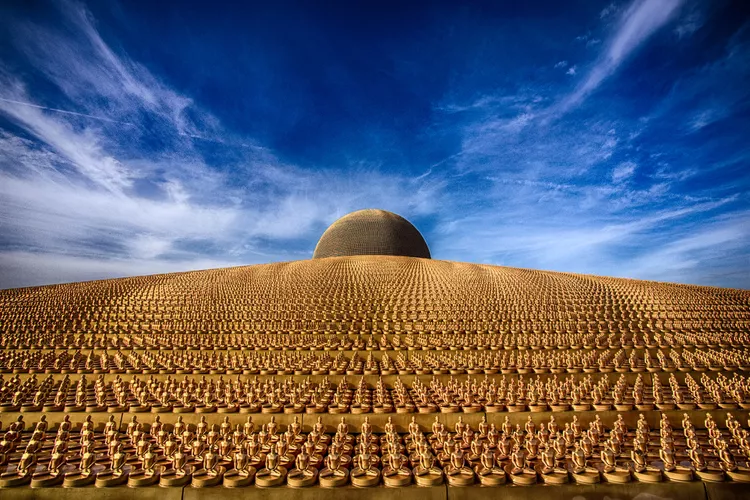Article Summary
Exploring Wat Phra Dhammakaya: The World’s Largest Temple
Temple Overview
One of the most intriguing aspects of travel is discovering strange but fascinating places that often sit right next to the most mundane locations. A prime example is Wat Phra Dhammakaya, the largest temple globally, located just a stone’s throw from Bangkok’s Don Mueang Airport. It’s so close that travelers can spot it while their planes take off or land; however, many might not even realize it is a temple.
This temple looks unlike any other you’ve seen before, especially compared to traditional Thai temples, and carries an air of controversy that complicates its image.
How Big is Wat Phra Dhammakaya?
Before diving into the controversies surrounding Wat Phra Dhammakaya, it’s essential to appreciate its scale. Constructed in 1970 on a sprawling 800-acre site, the temple boasts over 150 buildings that cover an expansive area of more than 320 hectares. At the center lies a unique sphere-shaped stupa decorated with 300,000 Buddha images, all roughly the size of a human monk.
In terms of capacity, estimating how many individuals can fit on the grounds is challenging. However, it’s believed that up to several hundred thousand people could congregate here. The administrative center assembly hall can accommodate more than 150,000 attendees, occupying only part of the entire temple grounds.
Moreover, over 3,000 monks reside at the temple daily, making it one of the most populated temples in Thailand. This community adheres to the same Buddhist philosophy embraced by the movement known as The Dhammakaya Movement.
Controversy of the Dhammakaya Movement
The controversies that envelop the Dhammakaya Movement and Wat Phra Dhammakaya are as expansive as its physical structure. Critics often allege that the organization contributes to the commercialization of Buddhism. The cost of operating the largest temple, estimated at around $1 billion, is borne solely by public donations.
There are claims from various quarters, including some Thai and foreign Buddhists, that the Dhammakaya Movement resembles a cult, having used exaggerated miracles and healing stories to ensnare followers and solicit financial support. Allegations of corruption, embezzlement, and fraud have surfaced; however, the Supreme Sangha Council ultimately cleared the movement of these accusations in 2006.
In a twist of events, a prominent Thai banker, Supachai Srisuppa-aksorn, was implicated in authorizing around 20 million dollars in fraudulent checks framed as donations from the temple to avert insolvency for his organization.
Interestingly, the Dhammakaya Movement once claimed knowledge of the reincarnation of Steve Jobs shortly after his passing in 2012, although this viewpoint was espoused by individual members rather than movement leadership. This claim garnered unexpected viral attention but did not significantly influence the broader movement.
The Other Side of the Dhammakaya Movement
Despite the controversies, not all aspects of the Dhammakaya Movement are negative. Its contributions extend beyond the grandiosity of Wat Phra Dhammakaya itself.
In fact, the movement has facilitated Buddhism’s outreach through impactful programs, including a noted decline in smoking and drinking among Thai people, which earned the Dhammakaya Foundation recognition from the World Health Organization in 2004. It has also provided support to smaller temples in Southern Thailand facing threats from insurgencies and has established a sophisticated satellite network transmitting teachings to over 18 countries worldwide, 24/7.
How to Visit Wat Phra Dhammakaya
Visiting Wat Phra Dhammakaya is relatively easy, as the temple is located about an hour north of central Bangkok by private vehicle or taxi. Due to a common preference among Bangkok taxi drivers to impose flat fares rather than use meters, it’s advisable to negotiate your fare beforehand, which should be at least 500 THB round-trip unless you converse fluently in Thai.
For those who prefer public transportation, several bus services operate regularly to the temple. For schedules, you can refer to the Dhammakaya Foundation’s website.
While the temple is welcoming to tourists, visitors should be mindful that aggressive recruitment efforts are generally not directed at non-Thais. However, approaching the temple with questions about its alleged cult status might not be advisable for the sake of courtesy.





